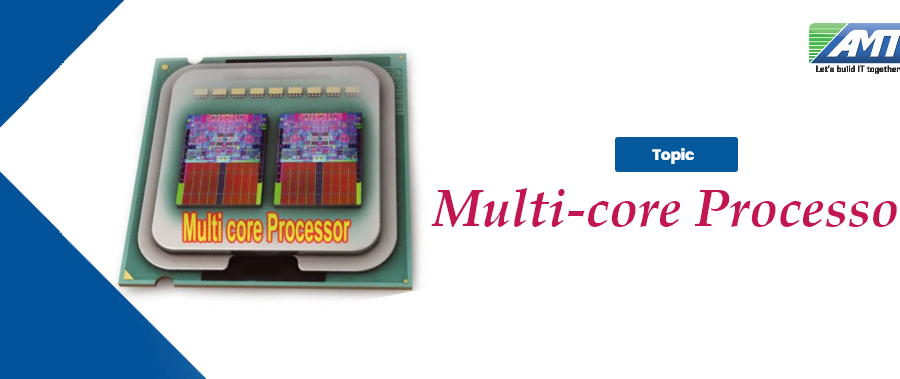A multi-core processor is a computer processor integrated circuit with two or more separate processing units, called cores, each of which reads and executes program instructions, as if the computer had several processors. The instructions are ordinary CPU instructions (such as add, move data, and branch) but the single processor can run instructions on separate cores at the same time, increasing overall speed for programs that support multithreading or other parallel computing techniques. Manufacturers typically integrate the cores onto a single integrated circuit die (known as a chip multiprocessor or CMP) or onto multiple dies in a single chip package. The microprocessors currently used in almost all personal computers are multi-core. A multi-core processor implements multiprocessing in a single physical package. Designers may couple cores in a multi-core device tightly or loosely. For example, cores may or may not share caches, and they may implement message passing or shared-memory inter-core communication methods. Common network topologies to interconnect cores include bus, ring, two-dimensional mesh, and crossbar. Homogeneous multi-core systems include only identical cores; heterogeneous multi-core systems have cores that are not identical (e.g. big.LITTLE have heterogeneous cores that share the same instruction set, while AMD Accelerated Processing Units have cores that don’t even share the same instruction set). Just as with single-processor systems, cores in multi-core systems may implement architectures such as VLIW, superscalar, vector, or multithreading.
Multi-core processors are widely used across many application domains, including general-purpose, embedded, network, digital signal processing (DSP), and graphics (GPU).
The improvement in performance gained by the use of a multi-core processor depends very much on the software algorithms used and their implementation. In particular, possible gains are limited by the fraction of the software that can run in parallel simultaneously on multiple cores; this effect is described by Amdahl’s law. In the best case, so-called embarrassingly parallel problems may realize speedup factors near the number of cores, or even more if the problem is split up enough to fit within each core’s cache(s), avoiding use of much slower main-system memory. Most applications, however, are not accelerated so much unless programmers invest a prohibitive amount of effort in re-factoring the whole problem. The parallelization of software is a significant ongoing topic of research.
While manufacturing technology improves, reducing the size of individual gates, physical limits of semiconductor-based microelectronics have become a major design concern. These physical limitations can cause significant heat dissipation and data synchronization problems. Various other methods are used to improve CPU performance. Some instruction-level parallelism (ILP) methods such as superscalar pipelining are suitable for many applications, but are inefficient for others that contain difficult-to-predict code. Many applications are better suited to thread-level parallelism (TLP) methods, and multiple independent CPUs are commonly used to increase a system’s overall TLP. A combination of increased available space (due to refined manufacturing processes) and the demand for increased TLP led to the development of multi-core CPUs.
Commercial incentives:
Several business motives drive the development of multi-core architectures. For decades, it was possible to improve performance of a CPU by shrinking the area of the integrated circuit (IC), which reduced the cost per device on the IC. Alternatively, for the same circuit area, more transistors could be used in the design, which increased functionality, especially for complex instruction set computing (CISC) architectures. Clock rates also increased by orders of magnitude in the decades of the late 20th century, from several megahertz in the 1980s to several gigahertz in the early 2000s.
As the rate of clock speed improvements slowed, increased use of parallel computing in the form of multi-core processors has been pursued to improve overall processing performance. Multiple cores were used on the same CPU chip, which could then lead to better sales of CPU chips with two or more cores. For example, Intel has produced a 48-core processor for research in cloud computing; each core has an x86 architecture.
Technical factors:
Since computer manufacturers have long implemented symmetric multiprocessing (SMP) designs using discrete CPUs, the issues regarding implementing multi-core processor architecture and supporting it with software are well known.
Additionally:
- Using a proven processing-core design without architectural changes reduces design risk significantly.
- For general-purpose processors, much of the motivation for multi-core processors comes from greatly diminished gains in processor performance from increasing the operating frequency. This is due to three primary factors:
- The memory wall; the increasing gap between processor and memory speeds. This, in effect, pushes for cache sizes to be larger in order to mask the latency of memory. This helps only to the extent that memory bandwidth is not the bottleneck in performance.
- The ILP wall; the increasing difficulty of finding enough parallelism in a single instruction stream to keep a high-performance single-core processor busy.
- The power wall; the trend of consuming exponentially increasing power (and thus also generating exponentially increasing heat) with each factorial increase of operating frequency. This increase can be mitigated by “shrinking” the processor by using smaller traces for the same logic. The power wall poses manufacturing, system design and deployment problems that have not been justified in the face of the diminished gains in performance due to the memory wall and ILP wall.
In order to continue delivering regular performance improvements for general-purpose processors, manufacturers such as Intel and AMD have turned to multi-core designs, sacrificing lower manufacturing-costs for higher performance in some applications and systems. Multi-core architectures are being developed, but so are the alternatives. An especially strong contender for established markets is the further integration of peripheral functions into the chip.
The above is a brief about Multi-core Processor. Watch this space for more updates on the latest trends in Technology.
